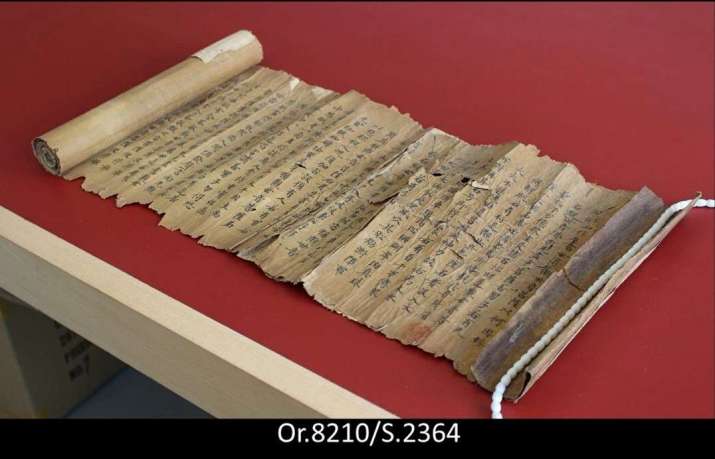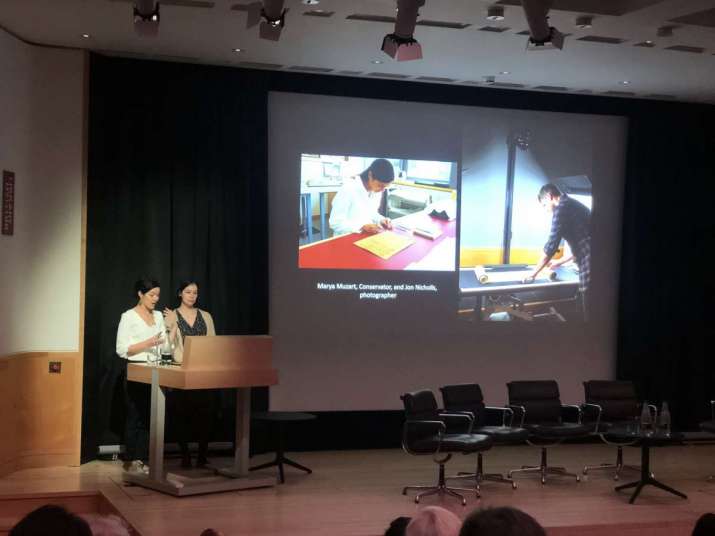FEATURES|THEMES|Exhibitions and Conferences
The British Library's Unlocking Buddhist Written Heritage Lectures: Mélodie Doumy and Marie Kaladgew on the Anatomy of a Lotus Sutra Scroll
 From youtube.com
From youtube.comThe British Library held a conference titled “Unlocking Buddhist Written Heritage” from 7–8 February this year, bringing together scholars from around the world to examine Buddhist texts and manuscripts through the lens of collections. This conference was held in partnership with the School of Oriental and African Studies and supported by the Robert H. N. Ho Family Foundation. The British Library team is releasing a series of recordings of the speakers’ presentations with slide visuals on the British Library YouTube playlist. In this article we look at a joint presentation by Mélodie Doumy and Marie Kaladgew, who spoke about the preservation and conservation of Buddhist scrolls.
Doumy is the curator of Chinese collections at the British Library, with a focus on the Stein Collection. Her interests include the material cultures of China and the Eastern Silk Road, Buddhism, the history of collections, and cultural diplomacy. One of her present projects is under the International Dunhuang Project (IDP): The Lotus Sutra Manuscript Digitization Project is conserving, digitizing, and publishing online nearly 800 manuscripts of the Lotus Sutra in Chinese by 2022. Kaladgew is scroll and digitisation conservator at the British Library. Her interests include conservation theory and ethics, and the relationship and comparative methodologies between Western and Asian approaches and techniques of conservation.
Doumy spoke first, turning the audience’s attention to Chapter 25 of the Lotus Sutra (Or.8.210/S.2364), noting that a close examination of a scripture chapter can not only reveal archaeological significance but also contextualize the living practices of the religious community of the text’s era and locations. Kaladgew argued that the discipline of manuscript conservation had developed in a similar way to that of medicine, taking advantage of scientific analysis and imagery, and deploying cutting-edge equipment and analysis. In taking the material chapter or fragment of a scripture as a case study, the first requirement is to know the “patient,” understanding its unique background and personal story. An examination and assessment of its physical condition is made, with photo documentation and recording. A careful evaluation of the risks and benefits of preservation is made before proceeding to treatment.
The special case of Or.8.210/S.2364
Kaladgew then focused on the scroll’s journey through time and space, tracing its discovery at the Cave of a Thousand Buddhas in the Mogao grotto complex near Dunhuang, Gansu Province. As a hub of Eurasian economic, political, and cultural activity between the Northern and Southern Silk Routes, Dunhuang saw its heyday between the fourth and 14th centuries, with Mogao seeing cultural influences of Central Asia, India, Tibet, and China. Mogao became a center for Buddhist art and worship but by the 20th century, the complex had been abandoned and was under the care of a self-appointed warden called Wang Yuanlu, who in 1900 accidentally discovered a walled-up chapel. Subsequently known as Cave 17, or the Dunhuang Library Cave, the small chapel contained an incredible trove of sealed texts (numbering in the tens of thousands), paintings, and other artifacts. For reasons unknown and debated, the cave was sealed away sometime in the 11th century. The majority of the texts are Buddhist-themed, although many contain information about China’s material culture and folklore at various points in medieval history.
The scroll in question, Or.8.210/S.2364, was sold by Wang at a bargain price to British-Hungarian explorer, collector, and surveyor Sir Aurel Stein, along with a huge haul of other items during Stein’s second expedition to Dunhuang in 1907. Or.8.210/S.2364 is a scroll that measures two meters in length, is dated to the seventh century, and is the 25th chapter of a Lotus Sutra copy based on the 406 CE Chinese translation by Kumarajiva (Taisho 272). It is being conserved and digitized as part of the Lotus Sutra Manuscript Digitization Project. Chapter 25 of the Lotus Sutra is dedicated to Avalokiteshvara or Guan Yin. This section is so popular that it was singled out as a standalone manuscript for copying and dissemination.
Diagnosis
Kaladgew then addressed the specific process of conservation along the methodology analogous to medical treatment. First, there is a physical examination to determine if the manuscript needs intervention (87 per cent of Cave 17’s scrolls examined so far need some form of intervention). The main physical characteristics of a Cave 17 text are: the paper is made from hemp and mulberry, or bamboo fibers, written with carbon ink, sometimes with red ink punctuation. The manuscript is made from several sheets of paper and rolled around a wooden core. It is a channel of faith and tool of ritual, but also an archaeological artifact that has been handled many times in many ways by diverse people from its creation to storage, travel, and many other stages.
Burns and oil stains on scroll paper might be evidence of religious rituals. Mold and water stains mean that they were stored in an environment—like a cave—that allowed infiltration of humidity or might have been subjected to a flood. Hand marks show the paper-making process and the varieties of paper quality and provenance. Bird and bat droppings indicate the environments in which the scrolls were stored, and the folds of papers indicate frequency of reuse.
Doumy outlined two types of material evidence on Or.8.210/S.2364 that indicate early attempts at preservation: one is the use of a vivid yellow dye called huang bo (from the tree species Phellodendron amurense), which is effective in protecting paper from mold and insects. The second is the reuse of hemp paper to patch the manuscripts together, meaning that the scrolls were damaged from use and deemed worthy of repair. Such repairs of tattered copies, as indicated in a practitioner’s colophon of the Nirvana Sutra (Or.8.210/S.2231), allow the text to be read and recited on behalf of sentient beings. Those that hear the scripture will then be protected from the three lower rebirths and eight worldly conditions while being able to perceive Amitabha Buddha. These spiritual aspirations would have been similar to those who were motivated to repair scrolls of the Lotus Sutra, and indeed the high-tech digitization programs of today are not too different in their intended outcomes.
 Mélodie Doumy and Marie Kaladgew present their talk on 8 February 2020. From the British Library
Mélodie Doumy and Marie Kaladgew present their talk on 8 February 2020. From the British LibraryTreatment
Kaladgew noted that contemporary repair methods have been considerably refined, with chemically stable papers and adhesives focused on stabilizing the object’s condition for sustained handling and preventing worsening of existing damage. Improving readability and keeping the text’s appearance when it was unearthed (the original look is impossible to restore) is a priority. Old patches, water stains, and other blemishes aren’t to be erased, but kept as part of the scroll’s journey through time and space.
Or.8.210/S.2364 was not in good shape when the treatment began, with the paper unsafe to roll and unroll, and large oil stains on the first panel, making it brittle. The paper, which was no longer the original material, was coarse, with attempts at consolidating the original composition causing further damage. Paste was liberally and unevenly applied, distorting the scroll, with patches overlapping each other, causing distortions, creases, and edge tears.
Kaladgew then laid out three possible routes to stabilize the scroll’s condition: no intervention, remedial treatment, or intervention. In the case of this scroll, the only feasible option was intervention proper. The process of treatment needed to begin with an assessment of what intervention meant, along with balancing risks and benefits. It is also limited by external factors such as time, money, availability of knowledge, and technological analysis.
It was necessary for the team to lift Or.8.210/S.2364’s paste lumps between the original scroll and patches to begin preserving it. The patches would be replaced upon consolidation of the scroll. The scroll was first surface-cleaned to pick up dirt, then humidified with de-ionized water to relax the paper. A sample of paste was then analyzed to identify its composition (Kaladgew noted that it proved to be a flour-based paste). The old patches were then lifted from the verso of the scroll. The scroll was then flattened and then repaired using infills of Japanese starch paste, before reattaching patches to with invisible Japanese paper tabs. The conservation scroll was increased in diameter using an archival-grade cardboard core for storage, handling, and preservation purposes.
Beyond visible wear and tear
Doumy elaborated on additional dimensions such as scientific imagery, which allowed the team to peek below and at the edges of the scroll, where faint writing additions had been glimpsed. Missing parts of characters, such as the date of the scroll, also indicated that the scroll was originally taller. The text fragments that previously weren’t visible also suggested that the scroll was originally commissioned by a female devotee.
Close collaboration and dialogue between conservators and curators have proved to be invaluable in the conservation and preservation of such scrolls. When opting for any type of treatment, a key priority is to not warp the understanding of future users, readers, or appraisers by limiting alterations to the outer appearances of the manuscript. Intervention is done only when necessary. These are not easy decisions, and information relating to the life of these collection items needs to be reflected in the cataloguing system of the institution—in this case, the British Library—to provide a full record of what repairs have been carried out to prolong the life of these precious archaeological, historical, and religious items.
Doumy and Kaladgew speculated that future infrared or other forms of visual technology would enable digitized versions to display images or text that could not be revealed for conservation reasons (for example, should removing a patch from a scroll be too risky). Taken together with the hard work of other scholars, their groundbreaking research and sympathetic methodology stand to contribute to Buddhist studies and Silk Road studies, and most excitingly of all, help interest groups across the board unravel Cave 17’s secrets.
See more
Lotus Sutra Project: Conservation of a burnt scroll (Or. 8210/ S.2155) (British Library)
Related features from Buddhistdoor Global
The British Library’s Unlocking Buddhist Written Heritage Lectures: Jann Ronis on “Indra’s Net for the Information Age”
New Channels of Discovery and Discussion: The British Library’s Unlocking Buddhist Written Heritage Lectures
An Interview with Birgit Kellner on the Role of Indian Manuscripts in the History of Tibetan Buddhism
Prof. T. H. Barrett and the State of Contemporary Buddhist Studies
Of Scriptures and Enchantment: An Interview with Sam van Schaik on a Grimoire of Magic Spells from Dunhuang
Related news from Buddhistdoor Global
Buddhist Digital Resource Center to Launch New Online Library of Buddhist Works
Buddhist Written Heritage to be Discussed at British Library Conference
British Library Exhibition Explores the Roots and Relevance of Buddhism
Buddhist Digital Resource Center, Internet Archive Share World’s Largest Collection of Tibetan Buddhist Literature
Rebranded Buddhist Digital Resource Center Embarks on Ambitious New Mission
Related blog posts from Buddhistdoor Tea House
“Unlocking Buddhist Written Heritage” at the British Library














